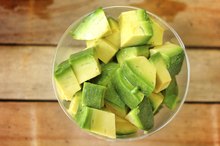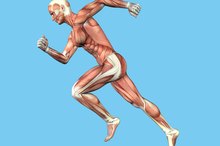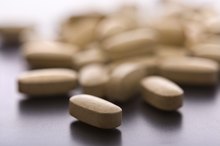What Are Phospholipids in the Diet?
Lipids account for approximately 40 percent of the organic matter in your body, which represents approximately 15 percent of your body weight. Lipids fit into four subclasses: fatty acids, triacylglycerols, phospholipids and steroids. Your cellular membranes consist primarily of phospholipids. These phospholipids contain both a phosphate group and a nitrogen-containing compound such as choline. When present in food, phospholipids allow fat and water to mix, in turn allowing fats to become part of your blood and move in and out of cells and vessels.
Phospholipid Structure
Phospholipids have a similar overall structure to triacylglycerols, but phospholipids have a phosphorus molecule in a location where a fatty acid molecule occurs in triacylglycerols. This slight difference in structure gives phospholipids one molecule that repels water and one molecule that attracts water. In water, phospholipids organize into clusters and carry fat-containing molecules such as vitamins, hormones and lipoproteins throughout your body. Phosphatidylcholine and phosphatidylserine are important phospholipids that your body requires for cell function.
- Phospholipids have a similar overall structure to triacylglycerols, but phospholipids have a phosphorus molecule in a location where a fatty acid molecule occurs in triacylglycerols.
Function of Phospholipids
What Role Do Lipids Play in the Human Body?
Learn More
Phospholipids serve as barriers for your cells and have a role in other specialized functions as well. Dipalmitoylphosphatidylcholine is the phospholipid responsible for helping your lungs expand during breathing. Cephalin is a phospholipid in your brain's white matter, neural tissue, nerves and spinal cord. Sphingomyelin, another phospholipid, is a source of ceramide, one of the substances your body needs to kill defective cells. Lecithin is one of the components of bile, a substance your liver produces to help with digestion.
- Phospholipids serve as barriers for your cells and have a role in other specialized functions as well.
- Lecithin is one of the components of bile, a substance your liver produces to help with digestion.
Phospholipids in the Diet
Your body has the capacity to produce some phospholipids naturally. You can also get phospholipids from dietary sources, however. The administration of phospholipids can influence functions associated with membrane proteins and correct them to some extent if needed 3. Phosphatidylcholine can help treat liver disease and serves as a precursor of choline, a compound in the synthesis of acetylcholine, which can improve both memory and muscle function 3. Check with your doctor before adding supplements to your diet.
- Your body has the capacity to produce some phospholipids naturally.
- The administration of phospholipids can influence functions associated with membrane proteins and correct them to some extent if needed 3.
Phospholipids Sources
Organic Compounds That Must Be in the Diet
Learn More
Egg yolks, liver, wheat germ and peanuts contain the phospholipid lecithin 4. Your body can only synthesize lecithin if you have sufficient choline in your diet, however. You can also find phospholipids in soy, milk and lightly cooked meats. Most fats, oils and fat-containing foods contain phospholipids as well.
- Egg yolks, liver, wheat germ and peanuts contain the phospholipid lecithin 4.
Related Articles
References
- “Human Physiology: The Mechanisms of Body Function”; Arthur Vander et al; 1998
- “Guyton and Hall Textbook of Medical Physiology”; John E. Hall; 2010
- "Harrison's Principles of Internal Medicine"; Dennis Kasper, Eugene Braunwald, Stephen Hauser, Dan Longo, J. Larry Jameson and Anthony Fauci; 2004
- NYU Langone Medical Center: Lecithin
Writer Bio
Allison Adams has worked as a registered dietitian since 1996. She began writing professionally in 2000, with work featured in a variety of medical publications such as "Women's Health Magazine" and the "New England Journal of Medicine." Adams holds a Master of Science in nutrition and food sciences from the University of Wisconsin-Madison.









